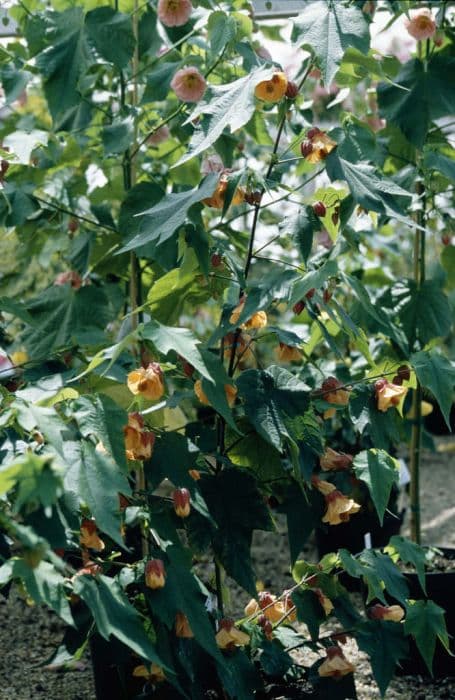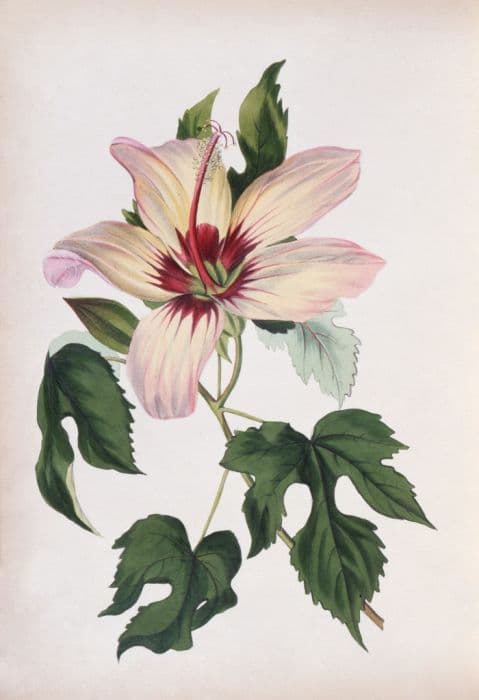Desert Mallow Sphaeralcea 'Childerley'

ABOUT
Sphaeralcea 'Childerley', often referred to as 'Childerley Globe Mallow', is a visually striking plant with a bushy, rounded growth habit. It is covered in soft, gray-green foliage that produces a gentle contrast against vibrant flowers. The leaves of this globe mallow are palmately-lobed, resembling a maple in shape, with a fuzzy texture that makes them soft to the touch. Throughout its blooming season, 'Childerley' Globe Mallow comes alive with a profusion of colorful flowers. Each blossom is cup-shaped, featuring five delicate petals that can be shades ranging from soft orange to a peachy pink hue. The flowers are borne in loose clusters and stand out against the foliage for their vivid coloration. The stems of the plant are slender and may have a slightly woody base. These stems are also covered in the same fuzzy texture as the leaves, helping the plant conserve moisture. In full bloom, 'Childerley' Globe Mallow presents a harmonious blend of delicate foliage and bright, cheerful flowers that attract pollinators such as bees and butterflies, adding to its ornamental value in a garden setting. Despite being quite resilient and drought-tolerant, its appearance does not diminish the soft, almost romantic aesthetic it brings to the landscape.
About this plant
 Names
NamesFamily
Malvaceae
Synonyms
Childerley Mallow
Common names
Sphaeralcea 'Childerley'.
 Toxicity
ToxicityTo humans
The plant known as desert mallow is not commonly known to be toxic to humans. Although it is not typically associated with serious toxicity, as with any plant, individual allergies or sensitivities could potentially cause mild irritation or discomfort if ingested or if the sap comes into contact with skin.
To pets
Desert mallow is also not commonly known to be toxic to pets. It is not listed among the plants that are known to cause serious harm to dogs, cats, or other domestic animals. However, ingestion of non-food plants can sometimes lead to gastrointestinal upset in pets, such as vomiting or diarrhea, especially if consumed in large quantities. As with any non-food plant, it is generally wise to prevent pets from ingesting desert mallow to avoid any potential stomach upset.
 Characteristics
CharacteristicsLife cycle
Perennials
Foliage type
Deciduous
Color of leaves
Green
Flower color
Orange
Height
2 feet (0.61 meters)
Spread
2 feet (0.61 meters)
Plant type
Shrub
Hardiness zones
6
Native area
North America
Benefits
 General Benefits
General Benefits- Attracts Pollinators: Sphaeralcea 'Childerley', commonly known as Childerley globe mallow, entices bees, butterflies, and other beneficial insects to the garden, enhancing pollination of surrounding plants.
- Drought Tolerance: Adapted to arid climates, this plant is highly drought-resistant, requiring minimal water once established and thus conserving water resources.
- Easy Care: Childerley globe mallow is known for being low-maintenance, needing only occasional care to thrive, which is ideal for busy gardeners or those with limited gardening experience.
- Landscape Aesthetics: With its attractive orange flowers, it adds a splash of warm color to gardens, borders, and landscapes, enhancing visual appeal.
- Wildlife Habitat: Provides food and shelter for local wildlife, including birds and insects, fostering a healthy and diverse ecosystem.
- Heat Resistant: The plant thrives in hot conditions, making it perfect for gardens in warm climates or for areas that receive full sun exposure.
- Soil Adaptability: Childerley globe mallow can adapt to a wide range of soil types, though it prefers well-draining conditions, making it versatile for different garden settings.
- Fast Growth: It grows relatively quickly, allowing for rapid establishment and filling in of garden spaces for a lush look in a short period of time.
 Medical Properties
Medical PropertiesThis plant is not used for medical purposes.
 Air-purifying Qualities
Air-purifying QualitiesThis plant is not specifically known for air purifying qualities.
 Other Uses
Other Uses- Dye Production: The flowers of the globe mallow can be used to produce natural dyes for textiles, yielding subtle shades dependent on the mordant used.
- Paper Making: The fibrous stems of the globe mallow may be incorporated into homemade paper for added texture and interest.
- Insect Habitat: Globe mallow can be planted to create habitat and food sources for pollinators like bees and butterflies as well as other beneficial insects.
- Photography: Due to its attractive blooms, the globe mallow provides a picturesque subject for nature and garden photography enthusiasts.
- Erosion Control: The plant's root system helps stabilize soil in areas prone to erosion, making it useful for xeriscaping and reclamation projects.
- Artistic Inspiration: The distinctive shape and color of the globe mallow flowers can serve as inspiration for artists and designers.
- Companion Planting: Globe mallow, when planted alongside vegetable gardens, may attract pollinators and beneficial insects that help in the growth of vegetables.
- Education: Globe mallow can be used in educational settings such as schools and botanical gardens to teach about xerophyte plants and desert flora.
- Wildlife Food Source: The seeds of the plant provide food for birds and small mammals in the ecosystem.
- Culinary Garnish: Although not widely known for its edibility, the petals can occasionally be used as a colorful garnish for salads and desserts.
Interesting Facts
 Feng Shui
Feng ShuiThe Desert Mallow is not used in Feng Shui practice.
 Zodiac Sign Compitability
Zodiac Sign CompitabilityThe Desert Mallow is not used in astrology practice.
 Plant Symbolism
Plant Symbolism- Resilience: The Sphaeralcea 'Childerley', commonly known as the desert mallow, thrives in arid environments, symbolizing the ability to endure and flourish under tough conditions.
- Adaptability: As a plant that can adapt to challenging climates, desert mallow represents the capacity to adjust and succeed in various situations.
- Beauty in Simplicity: With its simple yet brightly colored flowers, the desert mallow symbolizes finding beauty in the basic and unadorned aspects of life.
- Healing: Native Americans used various species of Sphaeralcea for medicinal purposes, giving the desert mallow a symbolic association with healing and health.
 Water
WaterThe Desert Mallow should be watered deeply but infrequently, aiming for about 1 gallon of water for a mature plant every 1 to 2 weeks during the growing season. In extremely hot and dry climates, the frequency may increase slightly, but always allow the soil to dry out between waterings to prevent root rot. During the winter months, reduce watering to once a month as the plant is dormant and requires less moisture. For younger plants, adjust the amount of water to the size of the plant, ensuring you soak the root zone.
 Light
LightDesert Mallow thrives in full sun conditions, requiring at least 6 hours of direct sunlight each day. Plant it in a location where it can receive unobstructed sunlight throughout the day for optimal growth. This plant is suited to the bright, intense sun found in arid and desert-like environments.
 Temperature
TemperatureDesert Mallow is tolerant of high temperatures and can survive in conditions exceeding 100 degrees Fahrenheit. It is cold-hardy to about 20 degrees Fahrenheit but performs best in temperatures ranging from 60 to 90 degrees Fahrenheit. Protect the plant from frost to ensure its survival.
 Pruning
PruningPrune Desert Mallow in early spring to remove any dead or damaged stems and to encourage fresh growth. Deadheading, or removing spent blooms, can promote more flowering throughout the season. In general, prune this plant annually or as needed to maintain its shape and health.
 Cleaning
CleaningAs needed
 Soil
SoilDesert Mallow prefers well-draining soil with a neutral to slightly alkaline pH of around 7.0 to 8.0. The best soil mix can consist of a combination of garden soil, sand, and compost to ensure adequate drainage and fertility.
 Repotting
RepottingDesert Mallow should be repotted every 2-3 years or when it has outgrown its current pot, to provide fresh nutrients and encourage continued growth.
 Humidity & Misting
Humidity & MistingDesert Mallow thrives in low to moderate humidity levels and does not require high humidity to grow well.
 Suitable locations
Suitable locationsIndoor
Ensure full sun, well-draining soil, and minimal watering.
Outdoor
Plant in full sun, well-drained soil, and water sparingly.
Hardiness zone
6-9 USDA
 Life cycle
Life cycleThe Sphaeralcea 'Childerley', commonly known as Childerley globe mallow, begins its life cycle when its seeds germinate in early spring, given appropriate conditions of warmth and moisture. Seedlings emerge with initial cotyledons before developing true leaves, which are typically lobed and hairy. As the plant enters its vegetative stage, it forms a bushy structure and grows rapidly in warmer months, enjoying full sun and well-drained soil. The Childerley globe mallow then enters its flowering stage in late spring or early summer, producing orange to salmon-colored flowers that attract pollinators and may continue to bloom sporadically throughout the summer. After pollination, the flowers develop into dry fruit capsules containing multiple seeds, which mature and are released in late summer to early autumn. The plant may die back in regions with colder winters but can re-sprout from its rootstock if it is a perennial variety, or seeds may overwinter and germinate the following spring, continuing the cycle.
 Propogation
PropogationPropogation time
Spring-Early Summer
Sphaeralcea 'Childerley', commonly known as the desert mallow, is typically propagated by seeds. The best time to propagate via seeds is in spring or autumn when the temperatures are not too extreme for seed germination. To propagate desert mallow by seed, one should first collect the seeds from the dried flower capsules of a mature plant. These seeds can then be sown directly into a well-draining soil mix and lightly covered with soil. It's important to keep the soil consistently moist but not waterlogged to encourage germination. Place the seed container in a warm area with plenty of indirect sunlight. Germination usually occurs within two to three weeks, after which the seedlings can be carefully transplanted to their final location once they are large enough to handle.









